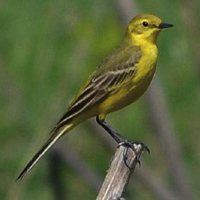The Gmelin’s wagtail Motacilla lutea: breeding range, migratory movements and wintering range

All claims expressed in this article are solely those of the authors and do not necessarily represent those of their affiliated organizations, or those of the publisher, the editors and the reviewers. Any product that may be evaluated in this article or claim that may be made by its manufacturer is not guaranteed or endorsed by the publisher.
Authors
The breeding range, the migratory movements, and the wintering range of the yellow-headed wagtail, called Parus luteus from Samuel Gottlieb Gmelin (now Motacilla flava lutea, or Motacilla lutea for some authors), has always been described in very general terms. Some authors pointed out that a modern and detailed map with the real distribution of the lutea is lacking, especially for evaluating the overlap of breeding ranges with other subspecies of Motacilla flava. The purpose of this study is to fill this gap in information by drawing up an updated map of the breeding range, as well as the wintering range and the migratory movements followed by this wagtail. These same aspects are also considered in perspective terms from 1851 to 2018 in order to assess any changes that have occurred over time. This study is based on data obtained from the consultation of 672 bibliographic sources, 40 travel reports, databases (including 6 relating to museum collections), and some websites.
Since the beginning of the 20th century, the breeding range of the lutea is located within the area of the Eurasian steppe and forest-steppe with the greatest abundance occurring in two areas in European Russia: the southern one in the floodplain of the Volga River and the northern one in the floodplain of the Kama River. Similarly to what is happening for the subspecies cinereocapilla and feldegg, from the end of the 20th century the lutea is extending its breeding range west and north. The advancement of the lutea to the western and northern regions of the European portion of Russia became possible due to the westward and northern advancement of key plant communities and food supply facilities of this bird. The lutea mainly uses two migratory routes: the Great Rift Valley Flyway and the Central Asian Flyway. The first is used by birds that nest in European Russia and western Kazakhstan to reach Africa, while the second is probably only used by the minority portion of the population that is present in the central and eastern part of Kazakhstan and in the Asian portion of Russia to reach India and Sri Lanka. Starting from the 21st century, the passage of birds towards north of the Black Sea seems to intensify. East Africa is the main wintering area of the lutea, but starting from the last decades of the 20th century, a small part of the birds traveling towards Africa interrupt their migratory journey and wintering in the Arabian Peninsula.
How to Cite
PAGEPress has chosen to apply the Creative Commons Attribution NonCommercial 4.0 International License (CC BY-NC 4.0) to all manuscripts to be published.







